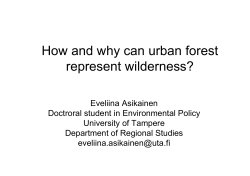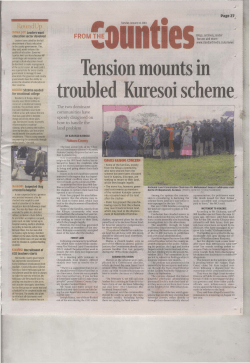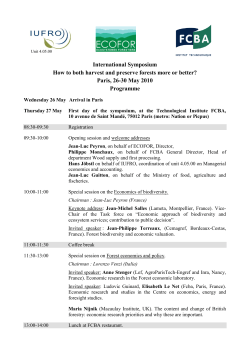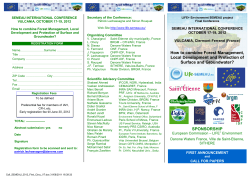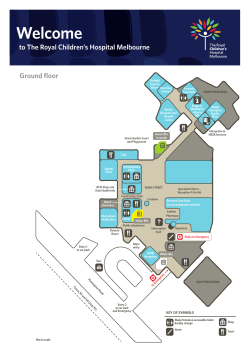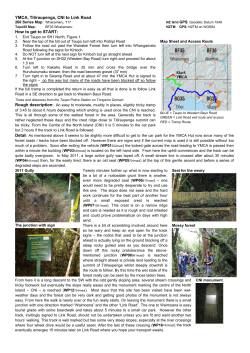
Document 250016
ROBERT G. BAILEY Rocky Mountain Forest and Range Experiment Station USDA Forest Service Fort Collins, Colorado 80526 within a geographical of regions or zones. This paper ex. on the 1976 map Ecore- gions of the United States. Four ecological levels are discussed- domain, division, province, and section-based getational ABSTRACT / As a means of developing reliable estimates of eco. framework plains the basis for the regions delineated on climatic and ve- criteria. Statistical tests are needed to verify and refine map units. system productivity, ecosystem classification needs to be placed Ecoregions are large ecosystems of regional extent that contain a number of smaller ecosystems.They are geographical zones that represent geographical groups or associations of similarly functioning ecosystems.Regional boundaries may be delineated on the basis of detailed information about ecosystems at the site level, or by analysis of the environmental factors that most probably acted as selectiveforces in creating variation in ecosystems. Using the latter approach, Bailey (1976) constructed a 1:7,500,000-scale map of the United States' ecoregions,with a brief narrative text that described the approach and development of the map. Bailey's map was developed as an inland counterpart to the regionalization of marine and estuarine systemsproposed by Cowardin and others (1979). An accompanying manual (Bailey 1980) describes and illustrates the regions shown on the map. However, a detailed explanation of the basis for the delineation of these regions was not included. This topic is addressedhere. The regionalization system described here is based on published information. This paper does not report on a data-supported study; but is, instead, an exposition of a rationale for data synthesis using existing small-scale maps. It presents one system for recognizing and displaying ecosystems with respect to geographical distribution. This system and others are undergoing rigorous evaluation to determine the most appropriate procedure for delineating ecosystemassociations (Driscoll and others 1981). Why Ecoregions Are a Necessary Classification The purpose of ecological land classification is to divide the landscapeinto variously sized ecosystemunits that have significance both for development of resourcesand for conservationof environment. More specifically, such units are the base for estimating ecosystemproductivity and the probable responses to management practices. To make such estimates, relationships between the needed production information and ecosysKEY WORDS: Ecoregions; Ecosystems; Ecological land classification; Mapping; Site production Environmental Management, Vol. 7, No.4, pp. 365-373 tem classesmust be developed. These relationships are called rules (Davis 1980). Rules take many forms, ranging from simple experienced-basedjudgments to multivariate regression models to complex mathematical simulations. Application of theserules is firmly basedupon conceptsof transfer by analogy. Thus, the rules necessaryfor estimation of productivity are extrapolated from experimental sites or from management experience to analogous areas defined by classification. Such methods do not require any prior knowledge of functional relationships between site parameters and the specific form of biological production, although such criteria may be incorporated. The land as a holistic ecosystemor separate major component (for example, soil) is classified on the basis of a number of observedand measurable characteristics. Subsequent evaluation is based on the hypothesis that all replications of a physically defined and characterized ecosystem or component class will respond in a similar way to management for any specified level of use. This hypothesis has been questioned by a number of research workers on the grounds that correlations between ecosystemand component classesand production are generally low. One of the ways to establish reliable site-production relationships is to identify homogeneousgeographical strata where similar ecosystemshave developed on materials having similar properties (Rowe 1962). For example, similar sites (those having the same landform, slope, parent material, and drainage characteristics) may be found in several climatic regions. Within a region, these sites will support the same vegetation communities, but in other regions vegetation on the sites will be different. Thus, beach ridges in the tundra region support low-growing shrubs and forbs, whereas beaches in the subarctic region usually have dense growth of black spruce or jack pine. Soils display similar trends, as the kind and development of soil properties vary from region to region on similar sites. The depth of the thawed layer and the form and kind of surface expression of permafrost on similar sites also vary between regions but remain relatively constant on comparable sites within a region. Ecoregions, therefore, define broad areas where one can expect to find the same kinds of vegetation and soil associationson similar sites.~ @ 1983 Springer-Verlag New York Inc 366 A.G. Bailey Ecoregions have at least two important functions for management. First, a map of such regions suggestsover what area the productivity relationships (rules) derived from experiments and experience can be applied without too much adjustment. Second, they provide a geographical framework in which similar responses may be expected within similarly defined sites. Methods of site classification involving such a geographical framework have been employed with successfor over 50 years in Europe. The Baden-Wiirttemberg system of southwestern Germany as described by Spurr and Barnes (1980) is perhaps the best example. Similar methods have proliferated widely in Canada. Criteria Used in Delineating Ecoregions Because information about variation among ecosystems throughout the country is limited, a national zoning system must be based primarily on criteria that reflect causal environmental factors. For broad-scale subdivision of a continent into a small number of large units, the large ecologicalclimate-zones present an obvious means of approach. Becausethe formation of soils and vegetation types and, to a lesserdegree, of fauna is determined primarily by the climate. The macroclimate is the best reflection of zonality. Surface configuration, which is partly the result of internal forces, is less influenced by the climate than either vegetation or soil; but the influence is great enough for the minor features to reflect the climate of the area where they are found. For further subclassification beyond climate, the macrofeatures of the vegetation appear to be the appropriate criteria for defining secondary divisions (Damman 1969, Kuchler 1973). Although only a result, vegetation is important as a criterion in the delineation of geographical zones becauseit affords a very delicate index of climate. The predominance of vegetation in the landscape also ensures its consideration in any scheme of zoning. Usually, the boundaries of vegetationally defined regions coincide with those of major relief units; this strengthens the primary division. However, the surface features are more useful at lower levels, that is, for subdividing the biotically circumscribed areas. The concept of climate as expressedby vegetation has been used frequently as the basis for delineating broad-scale ecological regions. Of immense significance for the development of the concept was the work of Dokuchaev (1899). This author pointed out that natural conditions are characterized by many common features within the limits of extensive areas (zones) and that these features change markedly in passing from one zone to another. In subsequent studies, Grigor'yev and Budyko (Grigor'yev 1961) established that the boundaries of geographical zones are determined to a considerable extent by climatic factors. Every feature with a distribution that broadly conforms to climate is termed zonal. The term azonal describesprocesses or features that occl,ir in several zones. For example, wetlands are not associatedwith a particular climatic zone. Efforts to divide the world into ecological regions have been based primarily on the distribution of climate-vegetation zones (for example, Herbertson 1905, James 1951, Biasutti 1962, Udvardy 1975). Recently, Walter (1977, Walter and Box 1976) presented a scheme for classifying the world into a hierarchy of ecosystemsfrom a climatic viewpoint. In Russia, Berg (Isachenko 1973) detailed landscape zones based on climate, while similar work was developed by Passarge (Troll 1971) in Germany, and Galoux (Delvaux and Galoux 1962) in Belgium. Some systems for the classification of climates (Koppen 1931, Thornthwaite 1931, 1948) seek to define climatic units that will correspond to major vegetation units. A number of authors (for example, Merriam 1898, Hopkins 1938) have sought to define life zones primarily on the basis of climate; the system of Holdridge (1947, Tosi 1964) employs a complex classification of zones by both temperature and moisture conditions. In Canada, the concept of forest ecosystemregions (there called site regions) was developed by Hills (1960) based on macroclimate. Simliar work has been done in other parts of Canada (Crowley 1967, Burger 1976). Krajina (1965) has delineated the biogeoclimatic zones of British Columbia. Climatic regionalization is used in biophysical or ecological land classification throughout Canada (Wiken and Ironside 1977). Of the variety of classifications available, the one devised by Crowley (1967) has been adopted as most suitable for the current purpose. A hierarchical order is established by defining successivelysmaller ecosystemswithin larger ecosystems(Figure 1). First, subcontinental areas,termed domains, are identified on the basis of broad climatic similarity, such as having dry climates. Climate is emphasized at the broadest level becauseof its overriding effect on the composition and productivity of ;.cosystems from region to region. The domains are quite heterogeneousand are further subdivided, again on the basis of climatic criteria, into divisons. The divisions correspond to areas having definite vegetational affinities (prairie or forest) and falling within the same regional climate, generally at the level of the basic climatic types of Koppen (1931) or of Thornthwaite (1931, 1948); usually the zonal soils are also related. Dry climates, for example, are separated into semiarid steppe and arid desert. A major exception to this is that the dry western side of the humid continental and subtropical climates, which is very extensive in central North America, is distinguished as subhumid prairie (Borchert 1950). Within a division, one or several climatic gradients may affect the potential distribution of the dominant vegetation strata. Within the arid zone, for example, deserts that receive onlv winter rain (Sonoran Desert) can be distinguished from Delineation of Ecosystem Regions 367 Figure 1. A hierarchy to the fourth level for ecosystemregions within the Humid Temperate Domain. those that receive only summer rain (Chihuahuan Desert). Within the steppe zone, a semiarid steppe(short-grass prairie) climate that has a dry summer seasonand occasional drought can be distinguished from an arid semidesert (sagebrush) climate that has a very pronounced drought seasonplus a short humid season. A southern (coniferous forest) climate and northern (forest-tundra) climate can be distinguished within the Subarctic Division of the Polar Domain. These climatic subzonesare evident as areas covered by the same dominant vegetation on sites supporting climax vegetation (Weaver and Clements 1938). Such sites are uplands, with well-drained surface, moderate surface slope, and we!l-developed soils. The climax vegetation corresponds to the major plant formation (for example, deciduous forest) characterized by uniformity both in physiognomy and in the structure of the climax type. Each climatic subzone comprises both the climax formation and all the successionalstages within its geographical area. Divisions are subdivided into provinces on the basis of the climax plant formation that geographically dominates the upland area of the province. Boundaries drawn on the basis of this broad criterion are often coincident with the major soil zones which, therefore, serve as supplemental criteria for delimiting provinces. Provinces are further subdivided into sections on the basis of differences in the composition of the climax vegetation type. Thus, the summer green deciduous forest of eastern North America is fairly homogeneous in its main structural features from east to west and north to south; but, five discrete climax associations can be recognized on the basis of floristic composition: oak-hickory, beech-maple, Appalachian oak, mixed mesophytic, and maple-basswood. The sections correspond generally to the potential natural vegetation types of Kuchler (1964). The vertical arrangement of the ecological systems in mountainous areas, with their various altitudinal belts, poses a problem. Such systems do not have the same climate as the adjacent lowlands, but they do have the same climatic regime (cycle of weather phenomena). These systemsdo not belong to the zones; rather, each mountain range forms a certain ecological unit in itself, which depends on the relations within the zone(s) in which it is located. This results in a certain zonal relationship, which also affects the vertical climate-vegetati°n.soil zonation within the mountain range. The earlier view that the upward sequence of altitudinal belts in the mountains represents a short repetition of the zonal arrangement from south to north (in the Northern Hemisphere) rests only on very superficial comparisons. The climate of an altitudinal belt in the mountains is always different from the climates of a northerly climate zone. The latitude is different, as are the day length, the solar declination, the length of the season,and the precipitation pattern, the level of which generally increases upward in the mountains as a result of the ascending rain. Between the individual altitudinal belts, there is a lively exchange of materials: water and the products of erosion move down the mountains; updrafts and downdrafts carry dust and pieces of organic matter; animals can move easily from one belt into the next; seeds are easily scattered by the wind or propagated by birds. The vertical belts, as a result, are not always as sharply separated from each other as are the climatic zones. The geographical area over which a sequence of belts extends is consideredto be a large ecological unit, designatedby the term highland province. In this system,the montane forest belt is not treated as a separate zone. The montane belt is only one member of the total sequenceof altitudinal belts. Montane belts in mountainous areas of different climatic zonesare just as distinct from one another as the montane belt is from other 368 R. G. Bailey altitudinal belts in the same zone. For example, the montane coniferous belt appears in the subarctic zone as spruce-fir forest, while in the steppe it is represented by a fir and pine forest. The structure of the stratification (that is, the number and sequenceof strata or belts) within a single zone is usually quite uniform. The variant types of vertical stratification are distinguished, in the main, not by the number of belts in the sequence but by the existence of certain plant speciesin individual belts. Thus, all mountain systemsthat lie within the steppezone have a uniform system of belts, yet they reveal certain partial differences in character. In the forest of the northern Rocky Mountains, the montane belt consists of grand fir-Douglas-fir forest; within the central region, only of Douglas-fir; and in the south, of ponderosa pine-Douglas-fir forest. The term highland section is applied to these different areas (forest types). Highlands are distinguished where, becauseof the influence of altitude, the climatic regime differs substantially from that in adjacent lowlands so that there is complex vertical climatevegetation-soil zonation. As a result, the levels appear as follows: Domain Division I Province4. Lowland Section I Highland Province 4. Highland Section All levels are needed to denote a particular area within the complete hierarchical system. For example, the Colorado Piedmont is part of the Grama-Buffalograss Section of the Great Plains Short-grass Prairie Province within the Steppe Division of the Dry Domain. The Cascade Range represents the Silver Fir-Douglas-fir Forest Section of the Pacific Forest Province, which belongs to the Marine Regime Highlands Division of the Humid Temperate Domain. The ecoregions of the United States listed in Table 1 are shown in Figure 2, which also shows the distribution of ten marine and estuarine provinces proposed by Cowardin and others (1979). Mapping Procedures When considering ecoregion differences, one should realize that regional boundaries indicate where significant ecological changes are taking place, often over a transitional zone. Therefore, the definitions of the limits will always be somewhat subjective. A boundary is placed where changes in the climate-vegetation-soil conditions appear to be most pro- 2. Lowland nounced or significant compared with adjacent areas. A line drawn in this way is only an approximation showing where most of the changes take place; many local variations become obvious when smaller areas are mapped in more detail. For this reason, a particular soil name or vegetation type may be applied to two adjacent ecoregions when site conditions are similar in these two regions. This situation usually exists only within a limited area on either side of a regional boundary line; as the distance from the boundary line increases, climatic change is sufficient to produce major, significant differences in similar site conditions. Because vegetation serves an an indicator of climate, its geographical distribution servesas a primary recognition criterion for regional boundaries. It is important to note again that usually variation in vegetation is essentially continuous, and degreesof difference form a full spectrum from insignificant to complete. Consequently, the placement of the boundaries is inherently subjective. The vegetation of the United Statesis described and mapped in "Potential Natural Vegetation of the Conterminous United States" (Kuchler 1964) at a scale of 1:3,168,000. Kuchler's map was used in conjunction with maps of climatic regions as the base map for delineating ecoregions. As a first step in regionalizing Kuchler's map, all lands were divided into lowlands and highlands. The pattern of montane vegetation as exhibited on the map was sufficient to identify these areas as a first approximation. These areas were further refined by reference to Hammond's (1964) land-surface form map (scale 1:5,000,000). Hammond's high mountains (less than 50"10of area gently sloping with local relief over 900 m) correlate well with the patterns of montane vegetation shown on Kuchler's map. However, the vegetation boundaries and the orographic boundaries do not always coincide in detail. For example, the vegetation of the basal plain commonly does not stop at the foot of the mountain but extends up the lower slopes. In this case, the orographic boundary is the one that stands out most clearly and is, therefore, treated as the ecoregion boundary, even though this choice is essentially arbitrary. For the purpose of the ecoregion map (Bailey 1976), the working definition of highlands that was adopted was an area in which the relief must be high enough to bring about a differentiation of the vegetal cover with elevation. In addition, this differentiation must be great enough to cause a change in life form, for example, from desert shrub to forest. The basic idea was to identify regions based not on orography alone, but on vegetation as the result and index of orography and climate. Such a definition would include high mountains such as the Colorado Rocky Mountains but would exclude the lower relief Appalachians. Although the widely spaced ranges of the southwest exhibit such zonation, the region as a whole is occupied largely by gently sloping plains. Thus, at the level of Delineation of Ecosystem Regions Table 1 1000 2000 Scheme for a fourth-order ecosystem regionalization Polar Domain 1200 Tundra Division 1210 Arctic Tundra Province 1220 Bering Tundra Province Highlands) M1210 Brooks Range Province 1300 Subarctic Division 1310 Yukon Parkland Province 1320 Yukon Forest Province Highlands! M1310 Alaska Range Province Humid Temperate Domain 2100 Warm Continental Division 2110 Laurentian Mixed Forest Province 2111 Spruce-fir Forest Section 2112 Northern Hardwoodsc-Fir Forest Section 2113 Northern Hardwoods Forest Section 2114 Northern Hardwoods-Spruce Forest Section 369 of the United States. 2530 Tall-grassPrairie Province 2531 BluestemPrairie Section 2532 Wheatgrass-Bluestem-Needlegrass Section 2600 2533 Bluestem-Grama Prairie Section Mediterranean Division 26to California GrasslandProvince Highlands! M2610 Sierran ForestProvince M2620 California Chaparral Province 3000 Dry Domain 3100 SteppeDivision 3110 GreatPlainsShort-grassPrairie Province 3111 Grama-Needlegrass-Wheatgrass Section 3112 Wheatgrass-Needlegrass Section 3113 Grama-BuffalograssSection 3120 PalouseGrasslandProvince 3130 IntermountainSagebrushProvince 3131 SagebrushWheatgrassSection 3132 LahontanSaltbush-Greasewood Section 3133 Great BasinSagebrushSection 3134 BonnevilleSaltbush-Greasewood Section 3135 PonderosaShrub ForestSection 3140 Mexican Highlands Shrub SteppeProvince Highlands! M2110 Columbia ForestProvince M2111 Douglas-fir ForestSection M2112 Cedar-Hemlock-Douglas-fir ForestSection 2200 Hot ContinentalDivision 2210 EasternDeciduousForestProvince 2211 Mixed MesophyticForestSection Highlands! 2212 Beech-MapleForestSection M3110 RockyMountain ForestProvince 2213 Maple-BasswoodForest+ Oak M3111 Grand Fir-Douglas-fir Forest SavannaSection Section 2214 AppalachianOak ForestSection M3112 Douglas-fir ForestSection 2215 Oak-Hickory ForestSection M3113 PonderosaPine-Douglas-fir 2300 SubtropicalDivision ForestSection 2310 Outer CoastalPlain ForestProvince M3120 Upper Gila Mountains ForestProvince 2311 Beech-Sweetgum-Magnolia-Pine-Oak P 3130 ColoradoPlateauProvince ForestSection P3131 juniper-Pinyon Woodland+ 2312 SouthernFloodplain ForestSection Sagebrush-Saltbush Mosaic 2320 SouthernMixed ForestProvince Section 2400 Marine Division P3132 Grama-GalletaSteppe+ 2410 Willamette-PugetForestProvince juniper-Pinyon Woodland Highlands! Section M2410 PacificForestProvince A3140 Wyoming BasinProvince M2411 Sitka Spruce-Crear-Hemlock A3141 Wheatgrass-NeedlegrassForestSection SagebrushSection M2412 RedwoodForestSection A3142 Sagebrush-Wheatgrass Section M2413 Cedar-Hemlock-Douglas-fir 3200 Desert Division ForestSection 3210 ChihuahuanDesertProvince M2414 California Mixed Evergreen 3211 Grama-TobosaSection -ForestSection 3212 Tarbush-CreosoteBush Section M2415 Silver Fir-Douglas-fir Forest 3220 AmericanDesert (Mojave-Colorado-Sonoran) Section Province 2500 Prairie Division 3221 CreosoteBushSection 2510 Prairie ParklandProvince 3222 CreosoteBush-BurSageSection 2511 Oak-History-BluestemParkland 4000 Humid Tropical Domain Section 4100 Tropical SavannaDivision 2512 Oak + BluestemParkland Section 4110 EvergladesProvince 2520 Prairie BrushlandProvince 4200 RainforestDivision 2521 Mesquite-BuffalograssSection Highlands! 2522 Juniper-Oak-MesquiteSection M4210 Hawaiian IslandsProvince 2523 Mesquite-AcaciaSection IKey to letter symbols: M-Mountain, P-Plateau, A-Altiplano. 370 R. G. Bailey ~ .§ ~ "Q. "- >< .- .- oS ~~ tj E-- ,,; .- C/) ~ ci5 ] .2 .- :::> -= ... 0 .,0I: 8 'Qj .- ~ N Q) ~ 0) ~ ~ 371 Delineation of Ecosystem Regions generalization of the map, they are considered lowland regions. In addition to mountain systems,the extreme high-altitude phases of plains (altiplano) and plateaus should be distinguished so that the distinctive position of such plains as the Wyoming Basin and the Colorado Plateau may be appreciated. Within the lowland series, section and province boundaries were established by using the diagnostic criteria of Crowley (1967) to generalize Kuchler's map. The generalization was of two types. First, boundaries were simplified by elimating enclavesand peninsulas that were deemedto small to show on the finished small-scale map. (The smallest region shown on the map is about 11,100 km2 (4300 sq mi).) Second,there was a reduction in the number of Kuchler types. Some of Kuchler's mapping units show the presence of large areas of azonal soils such as sand plains and peat deposits. These units were combined with surrounding zonal types in delineating sections and provinces; this relegated edaphically controlled ecosystems to a lower level of classification and to more detailed maps. Lowlands and highlands were then grouped into larger climatic regions (domains and divisions) following the Koppen (1931) system.Koppen's systemis simple, is basedon quantitative criteria, and correlates well with the distribution of many natural phenomena, such as vegetation and soils. In the Koppen system,summarized in Tables 2 and 3, eachclimate is defined according to assigned values of temperature and precipitation, computed in terms of annual and monthly values. It has become the most widely used climatic classification for geographical purposes. Particularly useful in delineating climatic regions were the climatic map of the world, modified from the Koppen system (Trewartha 1943) at a scale of 1:75,000,000,and the climatic map of North America (Thornthwaite 1931) at a scale of 1:20,000,000. Boundaries of the climatic regions were altered in some cases to make them conform to vegetation boundaries. Testing and Validation As Rowe and Sheard (1981) point out, maps are hypotheses to be tested and improved. The unit areas delineated are hypotheses that arise from a knowledge of what is ecologically important. The regionalization of the United States, as just described, is the product of an ecological concept. A key hypothesis is that the large divisions, bounded by changes in climatic regime, are functionally different in important ways. Furthermore, it is hypothesized that similar sites within map units should respond in a similar way to management. Some land management agencies are currently using the ecoregion concept without formal validation, much as others have used Kuchler's (1964) map of potential natural vegeta- Table 2. Regional climates, based on the Koppen system of classification (1931), as modified by Trewartha (1943). Koppengroupsand types A-Tropical humid climates Tropical rainforest(Af) Tropical savanna(Aw) B-Dry climates Steppe(BSk) Desert(BWh, BWk) Dry domain Steppedivision Desert division C-Subtropical climates Mediterranean(Csa) Humid subtropical(Cfa) Humid temperatedomain Marine west coast (Cfb) Mediterranean division Subtropical division Prairie division I Marine division D-Temperate climates Humid continental, warm summer (ilia) Humid continental, cool summer (Dfb) Hot continentaldivision Prairie division) Warm continentaldivision Prairie division) Subarctic(Dfc, Dfd) Polar domain Subarcticdivision E-Polar climates Tundra (ET) Ice cap (EF) Table A 3. Tundra division Definitions and boundaries of Koppen system. Tropical forest climates; without frost. Coolest month warmer than 18°C (65°F). B Dry climates; evaporation exceedsprecipitation. BS-Steppe or semiarid climate. BW-Desert or arid climate. C Subtropical climates; 8 months or more warmer than 10°C (50°F); coolest month warmer than DoC (32°F) but colder than 18°C (65°F). D Temperate forest climates; 4-8 months warmer than 10°C (50°F); coldest month cooler than DoC (32°F). E Polar climates, warmest month colder than 10°C (50°F). ET -Tundra climate; warmest month colder than 10°C (50°F) but warmer than DoC (32°F). EF-Perpetual frost; all months colder than DoC (32°F). a-average temperature of warmest month warmer than 22°C (72°F). b-average temperature of warmest month colder than 22°C (72°F). c-fewer than 4 months warmer than 10°C (50°F). d-same as c, but coldest month cooler than -38°C (-36°F). f-no dry season; rainfall throughout the year. h-hot and dry; all months warmer than DoC (32°F). k-cold and dry; at least one month colder than DoC (32°F). s-dry seasonin summer. w-dry seasonin winter. 372 R.G. Bailey tion, on the assumption that nothing better is available. Thus, while on the surface it may appear that the ecoregion conceptis definitive, in fact the concept and map must be tested and validated before long-range analysis and planning are under- taken. If adequate data on productivity are collected from the regions and assembled,the hypothesis underlying the regionalization can be evaluated statistically, and the validity of the regional structure (map) objectively evaluated. A program of research to statistically test the ecoregion construct by using data to verify and refine the boundaries of ecoregions, the internal homogeneity of the regions and their subdivisions, and the general applicability of the ecoregion conceptto nationwide resource assessmentand planning is being developed. Summary The map of the ecoregions of the United States depicts ecosystemsof regional extent according to the Crowley classification, with climate and vegetation as indicators of the extent of each unit. Four ecological levels are shown. The broadest, domains, are based on observable differences that have developed largely because of prevailing climatic conditions. Then, on the basis of further climatic criteria, domains are broken down into categories called divisions which, on the basis of the climax plant formation that geographically dominates the area of the province, are subdivided into provinces. Provinces are subdivided into sectionswhich differ in the floristic composition of the climax plant formation. Highland provinces and sections are distinguished where, as a result of the influence of altitude, the climatic regime differs substantially from adjacent lowlands to cause complex vertical climate-vegetation-soil zonation. Acknowledgments I wish to thank J. F. Franklin, A. W. Kuchler, and J. S. Rowe for reviewing the manuscriptand for making several valuablesuggestions, which I haveincorporatedinto the text. Literature Cited Bailey, R. G. 1976. Ecoregionsof the United States (map). US Departmentof Agriculture, ForestService,Ogden,UT. Bailey,R. G. 1980.Descriptionof the ecoregionsof the United States. US Department of Agriculture, MiscellaneousPublication 1391, Washington,DC. 77 pp. Biasutti, R. 1962. II paesaggioterrestre,2nd ed. Unione Tipografico, Torino, Italy. 586pp. Borchert,J. F. 1950. The climate of the central North American grassland.Ann. Assoc.Am. Geogr.40:1-39. Burger: D. .1976. The concept of ecosystem region in forest site classification. Pages 1-6 in Proceedings XVI IUFRO World Congress, Oslo, Norway. Coward.in, ~. M., V. Carter, F. C. Golet, and E. T. LaRoe. 1979. Classification of wetlands and deepwater habitats of the United States. FWS/OBS-79/31. US Fish and Wildlife Service, Washington, DC. 103 pp. Crowley, J. M. 1967. Biogeography. Can. Geogr. 11:312-326. Damman, A. W. H. 1969. The role of vegetation analysis in land classification. For. Chron. 55:175-182. Davis, L. S. 1980. Strategy for building a location-specific, multipurpose information system for wildland management. j. For. 78:402-408. Delvaux, J., and A. Galoux. 1962. Les territoires ecologiques du sud-est beIge. Centre d'Ecologie generale. Travaux hors serie. 311 pp. Dokuchaev, V. V. 1899. On the theory of natural zones. Sochineniya (Collected Works) v. 6. Academy of Sciences of the USSR, Moscow-Leningrad, 1951. Driscoll, R. S., D. L. Merkel, J. S. Hagihara, and D. L. Radloff. 1981. A component land classification for the United States: status and plans. US Department of Agriculture, Forest Service, Fort Collins, CO. 77 pp. (mimeo). Grigor'yev, A. A. 1961. The heat and moisture regime and geographic zonality. Soviet Geography: Review and Translation 2:3-16. Hammond, E. H. 1964. Classesof land-surface form in the forty-eight states, U.S.A. Ann. Assoc. Am. Geogr. v 54, Map Supplement No.4. Herbertson, A. J. 1905. The major natural regions: an essay in systematic geography. Geogr. J. 25:300-312. Hills, G. A. 1960. Regional site research. Forestry Chronicle 36:401423. Holdridge, L. R. 1947. Determination of world plant formations from simple climatic data. Science 105:367-368. Hopkins, A. D. 1938. Bioclimatics: a science of life and climate relations. Miscellaneous Publication 280. US Department of Agriculture, Washington, DC. 188 pp. Isachenko, A. G. 1973. Principles of landscape scienceand physicalgeographic regionalization. Melbourne University Press, Carlton, Victoria, Australia. 311 pp. James, P. E. 1951. A geography of man. Ginn and Co., Boston, MA. 375 pp. Koppen, W. 1931. Grundriss der Klimakunde. Walter de Gruyter Co., Berlin. 388 pp. Krajina, V. J. 1965. Biogeoclimatic zones and classification of British Columbia. Pages 1-17 in V. J. Krajina, ed. Ecology of western North America. University of British Columbia Press, Vancouver, Canada. Kuchler, A. W. 1964. Potential natural vegetation of the conterminous United States (map and manual). American Geographical Society Special Publication 36. New York. 116 pp. Kuchler, A. W. 1973. Problems in classifying and mapping vegetation for ecologicalregionalization. Ecology 54:512-523. Merriam, C. H. 1898. Life zones and crop zones of the United States. US Department of Agriculture. Bull. Div. Biol. SUTV.10:1-79. Delineation of Ecosystem Regions Rowe,J. S. 1962.Soil, siteand land classification.ForestryChronicle 38:420-432. Rowe,J. S.,and J. W. Sheard.1981.Ecologicalland classification:a surveyapproach.Environ. Manage.5:451-464. Spurr,S. H., andB. V. Barnes.1980.Forestecology.John Wiley and Sons,New York, NY. 687pp. Thornthwaite,C. W. 1931.The climatesof North Americaaccording to a newclassification.Ceogr.Rev. 21:633-~55. Thornthwaite,C. W. 1948.An approachtowardsa rational classificationof climate.Ceogr.Rev. 38:55-94. Tosi,J. S. 1964.Climatic controlof terrestrialecosystems: a report on the Holdridge model.Econ. Ceogr.40:173-181. Trewartha, G. T. 1943.An introductionto weatherand climate,2nd ed. McGraw-Hill, New York, NY. 545pp. Troll, C. 1971.Landscapeecology(geoecology) and biogeocenologya terminologystudy. Ceoforum8:43-46. Udvardy, M. D. F. 1975. A classificationof the biogeographical provincesof the world. OccasionalPaper18. InternationalUnion for Conservationof Nature and Natural Resources,Morges, Switzerland.48 pp. Walter, H. 1977. Vegetationszonenund Klima: die okologische GliederungderBiogeosphare.EugenUlmer Verlag,Stuttgart.309 pp. Walter, H., and E. Box. 1976. Global classificationof natural terrestrialecosystems. Vegetatio32:75-81. Weaver, J. E., and F. E. Clements.1938. Plant ecology,2nd ed. McGraw-Hill, New York, NY. 601 pp. Wiken, E. B., and G. Ironside. 1977.The developmentof ecological (biophysical)land classificationin Canada. LandscapePlanning 4:273-275. 373
© Copyright 2025



